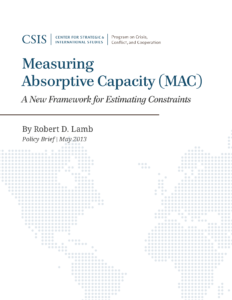 By Robert D. Lamb
By Robert D. Lamb
■ This policy brief describes a new framework for measuring absorptive capacity in international development, peacebuilding, and stabilization efforts. Absorptive capacity is the form and amount of foreign aid and attention that recipient communities, institutions, or societies can receive without suffering significant social, economic, or political disruptions.
Conventional measures of absorptive capacity focus on the degree to which a recipient can spend donor funds according to donor requirements. In more sophisticated conventional approaches, the focus is on recipients’ technical capacity to plan and implement programs or projects (“interventions”) according to donor standards, sometimes defined in partnership with recipients. Conventional prescriptions for overcoming the constraints on aid absorption tend to assume the standards, requirements, objectives, or designs of donor-funded interventions are “correct” and that recipients’ technical implementation capacity is what needs to be improved.
CSIS has recently completed research on the sources of absorptive capacity, however, and found that absorptive capacity is not an objective feature of recipient societies but a byproduct of particular donor-recipient relationships. More formally, absorptive capacity is an artifact of particular theories of change underlying the design and intent of particular donor-funded interventions.
> Read the full policy brief here
